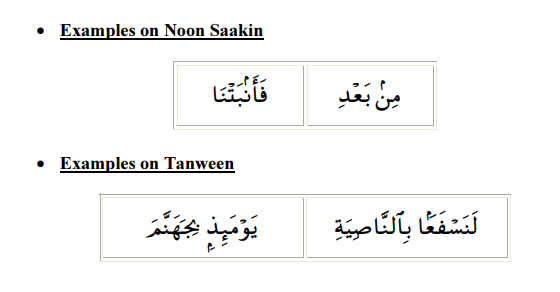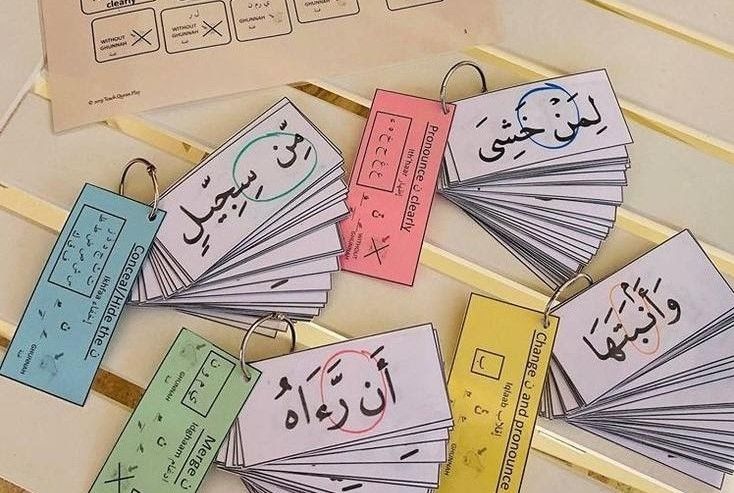The rules of Noon Saakinah and Tanween in Tajweed guide how these sounds are pronounced in Quranic recitation. They include Izhar (clear pronunciation), Iqlaab (changing into a Meem sound), Idghaam (merging sounds with or without nasalization), and Ikhfaa (partial concealment). These rules ensure proper and melodic recitation of the Quran.
Before we shed light on what Noon Saakin rules and tanween are, their definitions, and the difference between Noon Saakin and tanween, we need to make clear why to know these terms and apply them while reciting the Holy Quran.
As we know, reading the Quran well means reciting it correctly and in accordance with the tajweed rules. It was narrated from Aisha that the Messenger of Allah (PBUH) said: “The one who is proficient with the Qur’an will be with the noble and righteous scribes (the angels), and the one who reads it and stumbles over it, finding it difficult, will have two rewards.” [Ibn Majah]
Ibn Al-Jazari also said in his famous poem about the rules of Tajweed (what means): “The practical application of Tajweed is without doubt compulsory. Who does not read the Quran correctly is a sinner. The Quran was sent down to the Messenger of Allah in this form (with tajweed), which will not change for centuries. And after that, it was passed on to the next generations through reliable chains to our present-day Sheikhs and those with Ijazah) And it (tajweed) is also beautification of recitation and adornment of pronunciation and reading.”
Hence, Putting how to learn Tajweed, including Noon Saakin rules, a priority and giving it its dues effort and time is of great importance. Also, understanding our responsibilities so that we can receive his mercy is of our greatest duties.
Alhamdullilah that Allah does not give us loads we cannot carry so let’s now get started with the Noon Saakin rules:
Table of Contents
What is Noon Sakinah?
Noon Saakin means a Noon (ن) with a Sukoon/Jazm on it. The Noon Saakin can take place in the middle or end of any word. Tanween and Noon Saakin are read in one of the forms of Ikhfa, Izhar, Idghaam and Iqlaab.
Noon Saakin examples:

What is Tanween?
The change made by Tanween on the word is called “nunation”. Tanween signs add an “n” sound to the end of a word in certain circumstances. Tanween is when there are double Fatha (Nasb) the two lines above the word, double Kasra (Jar )the two lines under the word, and Dhamma (Raf). If Tanween is attached to the next letter, it is read, if it is paused on Tanween, it is not read. The stances of tanween in the word are as follows,
Example of Tanween:

- When a pause is made after the word which has Tanween Al-Fatha in the ending, Tanween is turned into an Alif and stopped by lengthening an amount of Alif .
- There will be no Alif if in Tanween Al-Fath if the last letter of the word is a Taa Marbutah (ة)ز
How Many Noon Saakin and Tanween Rules in English?
When we talk about Tanween and Noon Saakin rules, there are four related ones we should mention:
- Izhar
- Iqlaab
- Idghaam
- Ikhfaa
Noon Sakinah and Tanween are read in one of these four forms. Let’s examine what these Noon Saakin rules are and how we can distinguish the Tanween and Noon Saakin rules from each other!
Noon Saakin Rules
1. Izhar
The word “Izhar” means in the dictionary to explain something or to make something clear. If one of the throat letters we call “Huroof Halaqiyya” comes after Noon Sakinah or Tanween, we are talking about Izhar here.
When we pronounce the letter N clearly, we apply the Izhar rule. The Huroof Halaqiyya are: (ء – هـ – ع – ح – غ – خ)
Noon Saakin Izhar Examples:
2. Iqlab
If there is a letter Baa (ب) after the Noon Saakin or Tanween, here we have Iqlaab. Changing the sound of a Noon Saakin or Tanween into a Meem is the definition of Iqlaab. All you have to do is to stretch the sound to add Ghunna.
Usually, the letter Meem gives us a sign to recognize this rule. So it is all about turning one letter into another.
Iqlab Examples:

3. Idghaam
The third one of the Noon Saakin rules is called Idghaam. We will analyze it by dividing it into two headings as follows:
Idghaam with Ghunna
Idghaam is called adding one letter to another letter. If one of the letters (ي – م – ن – و) comes after Tanween or Noon Sakinah, it becomes Idghaam with Ghunna (nasal sound) for 2 counts.

Idghaam without Ghunna
If the letters Lam or Ra come after Tanween or noon Sakiin, it means there is Idgham without Ghunna. You have to pronounce it without stretching while the letter is spoken, it is passed quickly.

4. Ikhfaa
From each of the Noon Saakin rules we listed, there are only fifteen letters left that we didn’t mention. These are the remaining fifteen letters: (ت – ث – ج – د – ذ – ز – س – ش – ص – ض – ط – ظ – ف – ك – ق)
Ikhfaa occurs when one of these fifteen letters comes after tanween or noon Sakinah. While applying this rule, the tongue should not stick to the palate or upper front teeth. There should be a slight gap in between. The sound should come from both the mouth and nasal passages.
Ikhfa Noon Saakin Examples:

What Are Shaddah & Mushaddad?
Since we now know all the Noon Saakin rules and it is explained with simple Noon Saakin words, we can also go over the meaning of Noon Mushaddad and how to read it correctly when reciting the book of Allah SWT.
In the Arabic language, there are diacritics (Fatha, Dummah, Kasrah). Shaddah is also one of these diacritics. It brings together two of the same letter. The first letter is without any vowel and the second one is with a vowel as follows:

It is also advisable to check our detailed blogs about the Meem Sakinah rules with examples as well as the Laam Sakinah rules and how to master them in order to make everything clearer.
Noon Mushaddad and Meem Mushaddad Examples
Noon and Meem are called letters of Ghunna. And as we mentioned before while explaining the Noon Saakin rules, Ghunna is a nasal sound. When we see the letter Noon and Meem having Shaddah on them, we have to hold for a period of time with Ghunna. Briefly, if we come across a Noon or Meem Mushaddad (that has a Shaddah sign on it), we must do Ghunna of 2 beats on it.
Noon Mushaddad and Meem Mushaddad Examples:
Learn Quran And Tajweed Online
Riwaq Al Quran is a comprehensive online platform that offers personalized Quran, Arabic and Islamic Studies Online classes for individuals of all ages and backgrounds.
Their experienced instructors use a structured curriculum to cover Tajweed, Tafsir, and Memorization, providing easy and effective access to learning the Quran.
The advanced online classes allow for seamless communication and interaction between students and teachers. Join Riwaq Al Quran for a deeper connection with the Quran.
We offer several courses such as:
- Online courses for kids.
- Online Quran classes for kids and adults.
- Online Arabic courses
- Online Ijazah courses
- Online Islamic Studies courses.
Here are a sample of our set of Quran Courses that will be helpful for you:
- Online Tafseer Course: Delve into Quranic meanings with our insightful online Tafseer course.
- Noorani Qaida Online: Learn Quranic basics efficiently through our Noorani Qaida online program.
- Online Quran Recitation Course: Enhance Quranic recitation skills through our expert-led online course.
- Online Tajweed Classes: Master Tajweed rules for beautiful Quranic recitation in online classes.
- Quran Memorization Online Course: Memorize the Quran effectively with our specialized online memorization course.
- Online Qirat Course: Explore diverse Qirat styles with our comprehensive online Qirat course.
- Online Quran Classes for Kids: Nurture a love for the Quran in kids through interactive online classes.
Conclusion
The rules of Noon Saakinah and Tanween in Tajweed govern how these sounds are pronounced during Quranic recitation. These rules include Izhar, where the Noon Saakinah or Tanween is pronounced clearly when followed by throat letters; Iqlaab, where Noon Saakinah or Tanween changes into a Meem sound with nasalization if followed by the letter Baa; and Idghaam, where the sound merges into the next letter either with or without nasalization, depending on the following letter.
Additionally, Ikhfaa occurs when the Noon Saakinah or Tanween is partially concealed, creating a blend between the sounds, and applies to the remaining 15 letters. Understanding and applying these rules ensures proper Quran recitation, maintaining both clarity and melody in accordance with Tajweed principles.
We hope that we provided you with the opportunity to increase and improve your Tajweed knowledge. In case you have any questions, do not hesitate to contact us and ask for further explanation. Also, It is a great opportunity to enroll in our versatile Quran with Tajweed course delivered by highly qualified Quran tutors!




































